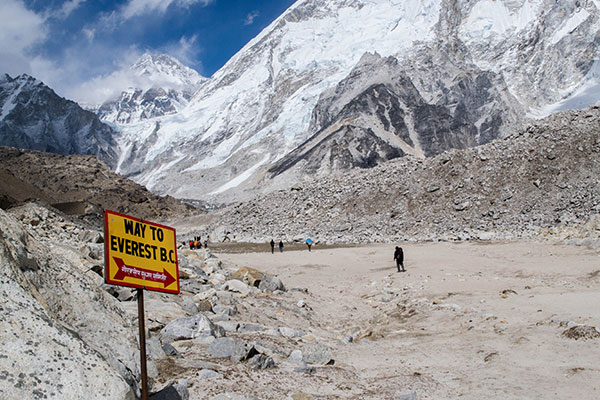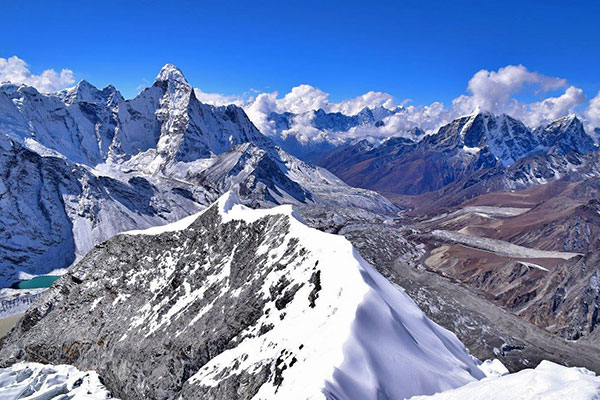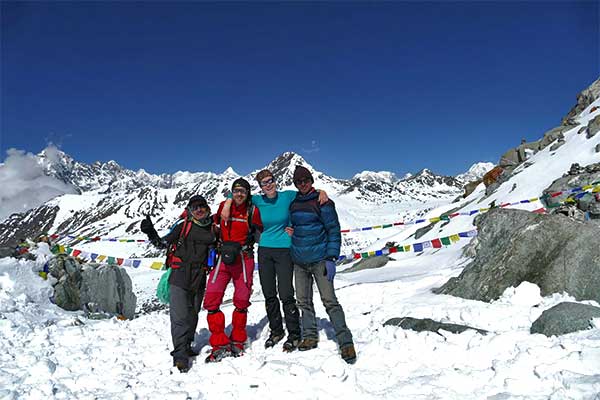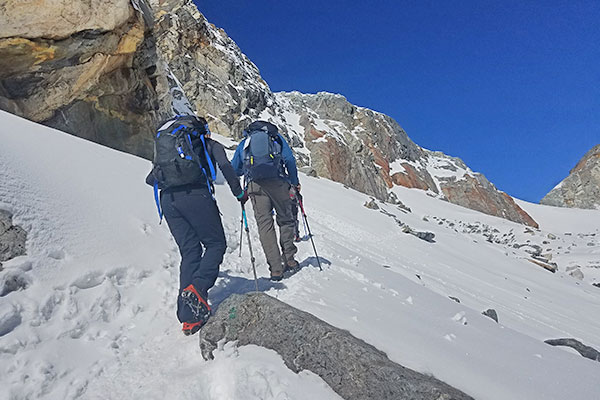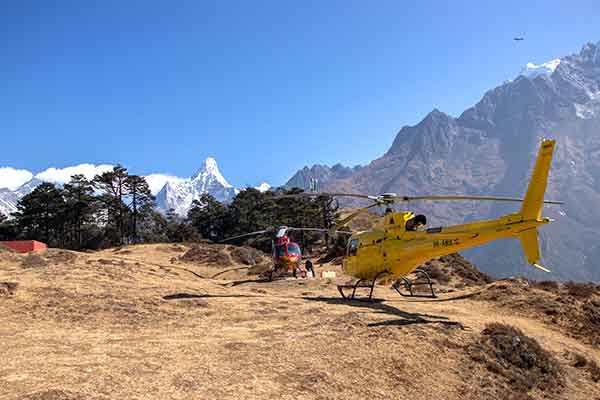Overview
Duration :
19 Days
Secondary Activity:
Nature and Sherpa Culture
Max altitude :
5,545m/18,192ft
Transportation:
Private Vehicle and Domestic Flight
Trip ends in:
Kathmandu
Accomodation:
Lodge and Tent Camp
Primary activity:
Trekking and Climbing
Group Size:
Min. 1 pax
Country:
Nepal
Trip starts from:
Kathmandu
Diffficulty:
Strenuous Plus
Meals:
Nepali and Continental
Best Season:
Autumn and Spring
Trip route:
Kathmandu-Lukla -Phakding-Namche Bazzar-Tengboche-Dingboche-Lobuche-Everest Base Camp-Gorak Shep-Kala Patthar-Lobuche-Lobuche Base Camp-Lobuche High Camp-Summit-High Camp-Lobuche High Camp-Orsho-Khumjung-Lukla-Kathmandu
Trip introduction
Everest Base Camp and Lobuche East Peak Climbing is another well-known trip that the popular Everest region has to offer for adventure lovers like you. By embarking on this journey, you will be experiencing all the moments of the Everest base camp trek. Like exploring Sherpa cultures, traditions, Kala Patthar hike, walk on Khumbu glacier, outstanding views of Khumbu glacier. And finally, summit the Lobuche peak.
Journey: Everest Base Camp and Lobuche East Peak Climbing
We start our Everest base camp and Lobuche East Peak climbing journey after your arrival at Kathmandu valley. Followed by cultural sightseeing and a short exciting flight to Lukla airstrip the next day. Initially, we start trekking in the Everest region from Lukla, Phakding, Sherpa village of Namche, a cultural hotspot. And visiting the ancient monastery at Tengboche, Dingboche, Lobuche. And finally, fulfill the desire of stepping at Everest base camp before descending at Gorkhashep.
On this trip, we won’t ever miss an opportunity to hike all the way towards Kalapathhar for viewing glorious Himalayan views like never seen before. Then only our real peak climbing adventure begins as we make our way from Lobuche to Lobuche high camp via Lobuche base camp. Our trained and professional Sherpa guides and climbing leaders will demonstrate and provide detailed instruction on using the climbing equipment like ropes, harnesses, crampons, and ice axe, etc. The summit of Lobuche peak also offers great views of snow-white Himalayan peaks like never seen before. It is definitely once in a lifetime opportunity. We will then return to Lobuche high camp, trek to Orsho, Khumjung, Lukla for a couple of days, and fly back to Kathmandu with great Everest memories.
Best Season and Physical Fitness
Best time to join this Everest base camp and Lobuche peak climbing adventure is from the months of March to May and October, November. As this trip involves high altitude trekking and peak climbing; you must be physically fit able to possess a passion for the same. Previous experience will always be handy but it is not mandatory. However, we ensure you will be 100% safe during the entire period of this trip. Join Nepal Mountain Trekkers for professional quality services. Contact us now for further inquiries.
Special Note:
If this itinerary doesn’t suit your requirement or if you want to customize it, please feel free to contact us. This trek could be customized as per your required time frame and budget limits.
Overview
-
Day 1Arrive in Kathmandu (1,300m /4,264 ft):
-
Day 2Kathmandu: Sightseeing and Trek Preparation:
-
Day 3Kathmandu – Lukla – Phakding (2,652m/8,700ft): 40 minutes flight, 3- 4 hours trek (Trekking times only):
-
Day 4Phakding – Namche Bazaar (3,440m/11,280 ft): 5 – 6 hrs:
-
Day 5Namche Bazaar: Acclimatization Day:
-
Day 6Namche Bazzar to Tengboche (3,870m/12,694ft): 5 – 6 hrs:
-
Day 7Tengboche to Dingboche (4,360m/14,300ft): 5-6 hours:
-
Day 8Dingboche: Acclimatization Day:
-
Day 9Dingboche to Lobuche (4,940m/16,207ft): 5-6 hours:
-
Day 10Lobuche to Everest Base Camp (5,364m/17,594ft) and back to Gorak Shep (5,170m/16,961ft): 9-10 hours:
-
Day 11Gorak Shep to Kala Patthar (5,545m/18,192ft) and back to Lobuche (4,940m/16,207ft): 7-8 hours:
-
Day 12Lobuche to Lobuche Base Camp (4,950m/16,240ft): 1-2 hours:
-
Day 13Lobuche Base Camp to High Camp (5,400m/17,712ft): 3-4 hours:
-
Day 14Lobuche High Camp to Summit (6,119m/20,070ft) and back to High Camp: 8-10 hours:
-
Day 15Lobuche High Camp to Orsho (4,160m/13,648ft): 8-9 hours:
-
Day 16Orsho to Khumjung(3,780m/12,402ft): 4-5 hours:
-
Day 17Khumjung to Lukla (2,860m/9,383ft): 7-8 hours:
-
Day 18Fly to Kathmandu:
-
Day 19Departure Day:
Detail Itinerary
Day 1 : Arrive in Kathmandu (1,300m /4,264 ft)::
Welcome to Kathmandu. You will be met by the representative from Nepal Mountain Trekkers after you shall reclaim your luggage and complete the formalities at the immigration desk at the airport. You will then be escorted to the hotel in a private vehicle for a comfortable stay during the time you will be in Kathmandu. After you reach the hotel, take rest proper rest in the hotel. Later in the afternoon, you may stroll around in the streets of Thamel for some shopping of gears for your expedition. If you don’t have anything as such, saunter around in the Thamel and nearby streets. Stay overnight in Kathmandu.
Day 2 : Kathmandu: Sightseeing and Trek Preparation::
An insightful and enriching day, today we shall go for the sightseeing and exploration of this beautiful and culturally rich city of Kathmandu. The prominent heritage and the favorites among the tourists are the 14th-century old sacred stupa of Swayambhunath which hosts whitewashed stupas, several big statues dedicated to Buddhist deities, and the beautiful view of Kathmandu. Another important site is the Boudhanath stupa, the largest stupa of its kind in the world, which hosts pilgrims, tourists, and followers circumambulating the stupa lying central to the complex and being lost in the relaxing chant of Buddhist mantras. Pashupatinath Temple is another star attraction in the city which is one of the most sacred Hindu temples around the world located at the bank of the holy Bagmati River. Besides these, the Durbar Square of Kathmandu with a large complex hosting the Royal Palace, ancient temples, houses, and museums may also be explored during the day. Later in the afternoon, we shall have a pre-trip meeting to discuss the necessary issues about the expedition. Use this to get clarified about the queries you have regarding the trip. Stay overnight in Kathmandu.
Day 3 : Kathmandu – Lukla – Phakding (2,652m/8,700ft): 40 minutes flight, 3- 4 hours trek (Trekking times only)::
Today we shall be heading for the trekking region in Everest on a short flight to Tenzing-Hillary Airport in Lukla. Starting early for the flight we fly over the vast landscape with changing landscape and valleys, rivers, terraced hills, and the views of the giant Himalayas in the far distance. The flight to Lukla and the amazing and dramatic scenery is a hint to the travelers about the breathtaking beauty and adventure that lies ahead in the trip. After landing in the Lukla airport, we shall meet with the remaining crews of our team, the porters, and other trekking staff, and head for the introductory trek of this expedition which is the trek to Phakding. The trek of around 4 hours begins with descending from the Lukla airport. After a short walk, we join the main trail that leads us towards the Everest Base Camp trekking past the stone walls, Chortens, and over the suspension bridge to reach the settlement of Thado Koshigaon. The trail to Phakding is then accompanied by the Dudh Koshi River which takes the trekkers past the viewpoint of mountain peaks, through smaller settlements and vegetations, and past the prayer wheels, prayer flags. Finally, the destination of Phakding is reached. Stay overnight in Phakding.
Day 4 : Phakding – Namche Bazaar (3,440m/11,280 ft): 5 – 6 hrs::
The trek for today begins after breakfast. In an interesting trek, we shall today cross over several suspension bridges and encounter relatively few uphill and downhill trek. The trail provides magnificent views of lofty peaks including Mt. Thamserku (6608m) as the trekkers reach the settlement of Benkar past the waterfall and after around past the waterfall. Moving further ahead in the trail we encounter further suspension bridges as we reach the Monjo village, the gateway to the Sagarmatha National Park (described by UNESCO as the heritage of universal value), and get our permits checked. Entering the national park, we reach Jorsale, the last village until Namche Bazaar. In a relatively enjoyable walk along the riverbed, we reach the Hillary suspension bridge which is the tallest point till now. After the bridge, we have a steep ascent till Namche Bazaar as we trek with the view of Everest, Lhotse, Tawache, and other sibling peaks. With a brief stoppage at Chautara to admire the view, we finally reach Namche which sits tucked away in the hills facing the giant Himalayas. Stay overnight in Namche Bazaar.
Day 5 : Namche Bazaar: Acclimatization Day::
On an important day with regards to the adaptation to the higher altitudes ahead in the trek, today we shall spend our day in Namche Bazaar and its surrounding areas. For acclimatization, trekkers need to hike to some higher altitudes and rest to the lower altitudes. This tourist hub of the Khumbu region, Namche Bazaar is in itself full of lodges, teahouses, souvenir shops, internet cafes, restaurants, bakeries, and others for enjoyment besides the Sherpa museum that provides insight into the history of mountaineering, flora, and fauna, and culture and tradition of local Sherpa community. Trekkers have several day hiking options for the purpose of acclimatization. Hike to the Everest View Hotel provides panoramic views of the mountains including the Everest, Ama Dablam, Nuptse, Lhotse, and others. The other hiking destinations are the twin villages of Khumjung and Khunde, and Thame which is the longer hike from Namche. The monastery with the scalp of Yeti is the attraction of Khumjung monastery in Khumjung which also hosts the Hillary School. Stay overnight in Namche Bazaar.
Day 6 : Namche Bazzar to Tengboche (3,870m/12,694ft): 5 – 6 hrs::
The trek starts with climbing to the ridge-top that offers a marvelous view of the mountains including Thamserku, Kusum Kangarib, and Kantega. Trekking further through the ridge-branch, we have the sight of mighty peaks such as Lhotse, Ama Dablam, Everest, Nuptse, and Tawache. Through the dense forest and the settlements of Sanasa and Kenjoma, we reach the trail junction where the trail to the Gokyo valley and the Everest Base camp meet. The trail ahead takes us to the riverbed of the mighty Bhote Koshi River through stone steps and after crossing the river on a suspension bridge, we shall reach Phunke Tenga which is marked by water-driven prayer wheels. The trail ahead of Phunke Tenga is a bit strenuous as you shall encounter a steep section that eases out relatively as you approach the forested areas in the trail. With the breathtaking view of the mountains in the background, you shall reach the gate welcoming you into the spiritual center of the Khumbu region, the settlement of Tengboche. Famous for the biggest monastery in the entire region with a large statue of Buddha, Tengboche also provides a magnificent view of the surroundings. Witness the religious ceremony in the monastery before you settle down in the hotel for rest. Stay overnight in Tengboche.
Day 7 : Tengboche to Dingboche (4,360m/14,300ft): 5-6 hours::
Our ascent continues to the higher altitude as we have Dingboche as the destination for today. Beginning with the view of sunrise over the Everest from this village, we head for Dingboche ahead in the trail in a gradual fashion. Through the Musk Deer trail, named due to the abundance of Musk Deer in the surrounding forest, we descent to the Deboche village and further on to the riverbed of the Imja River. Crossing over the river on a suspension bridge, we ascend gradually to Pangboche through several Chortens and mani walls and small villages. The view of the beautiful Ama Dablam peak from Pangboche during your tea break shall leave you smiling. Ahead of Pangboche, we shall trek most of the time close to the river and after crossing several suspension bridges, passing through some more villages, and trekking through a flat trail at one section, we reach the destination of Dingboche. This beautiful village which protects the fields with stone walls is a mesmerizing place in itself. Stay overnight in Dingboche.
Day 8 : Dingboche: Acclimatization Day::
Today we shall have another day for acclimatization at the high altitude. In this rarified atmosphere, we shall have some exploration to the surrounding areas so that our body adjusts to the lack of oxygen and we don’t suffer from altitude sickness. In order to keep ourselves active during this acclimatization day, we shall have a day hike. The popular day hike from Dingboche is to the Chhuung Ri which is a hill at the edge of the Chhukung valley above Dingboche. In a trail that becomes steep at times, trekkers experience a bit of physical challenge which is compensated by the outstanding views of the mountains. The ascent to the summit of the hill could take around 5 hours. The magnificent view of mountains such as Lhotse, Cholatse, Tawache, Awi Peak, Ama Dablam, Makalu, Island Peak, Thamserku, and many other lofty peaks, named and unnamed, are visible from the summit of the hill. Besides these peaks, the glorious view of Pheriche valley is another beautiful reward to the climbers. Apart from climbing the Chhukung Ri, trekkers also go to the base camp of the beautiful Ama Dablam Peak. Through the rough terrain and rocky paths, this day hike is perfect for acclimatization. Trekkers also opt for the hike to the ancient monastery of Nangkartshang. After having the surrounding explored, return to the camp for an overnight stay.
Day 9 : Dingboche to Lobuche (4,940m/16,207ft): 5-6 hours::
After the acclimatization in Dingboche, we are ready to move to higher altitudes in our trek. Starting with the view of mountain peaks, we head out of the Dingboche in a steep trail past a Chorten and climb the valley gradually to Dughla. Through the farmlands, meadows, and with the sight of majestic peaks overlooking the trail we reach Dugla. The trail ahead is steep as we climb to a ridge of Chukpi Lari that is home to the array of stone memorials built in honor of the climbers who lost their lives during their expedition to climb the mighty Everest. This makes the climbers and trekkers realize the fragility of life at this altitude. Past this area, we reach the lateral moraine of the Khumbu Glacier as the trail ease of a bit. With the view of high mountain peaks, we follow the trail to Lobuche, a collection of few teahouses beneath the glacial moraine and the lofty Lobuche Peak. Enjoy the breathtaking sunset above Nuptse Peak and get prepared for the ultimate destination of Everest Base Camp tomorrow.
Day 10 : Lobuche to Everest Base Camp (5,364m/17,594ft) and back to Gorak Shep (5,170m/16,961ft): 9-10 hours::
From Lobuche, one of the last overnight stops to the Everest Base Camp, we start our trek. Though the trail ahead is not a steep one but the altitude makes the ascent a difficult task. We trek for more than three hours past the lateral moraine of the Khumbu Glacier, hearing the slow-moving glacier crushing the rocks before we reach the much-awaited destination of Everest Base Camp. As we near the base camp, we have five of the world’s highest peaks in our vicinity. Trekking through the ridge for a couple of hours and enjoying the views of the peaks such as Pumori, Mahalangur, Nuptse, Khumbutse, we drop off to the glacial moraine and winding up the trail to the Everest Base Camp below the infamous Icefall. Decorated with colorful tents in the peak climbing season, Everest Base Camp gives you a euphoric feeling as you reach this natural amphitheater in the lap of Everest. After capturing some pictures as the memory of the ascent, we shall trek back to the Gorak Shep in around 3 hours. Stay overnight in Gorak Shep.
Day 11 : Gorak Shep to Kala Patthar (5,545m/18,192ft) and back to Lobuche (4,940m/16,207ft): 7-8 hours::
Get ready for one of the most beautiful mornings in the Himalayas as we shall go for the iconic Kala Patthar to have a view of Mount Everest. Starting before the day breaks, we shall move for Kala Patthar that seems like a brown hill dwarfed by the majestic Pumori Peak. After ascending for a couple of hours in a rather straight trail from Gorak Shep, where we shall be taking short breathes to catch our breath and take pictures during our climb, we reach Kala Patthar. We push ourselves to the rocky projection decorated by cairns and prayer flags for the ecstatic view when the sun throws its first ray on the peak of the tallest peak of the world. After viewing the beautiful scenery of sunrise and the Himalayas we shall descend to the Gorak Shep for some refreshment and lunch before moving down to Lobuche. This downhill walk from Gorak Shep shall mark another section of our expedition, the summit too lofty Lobuche East Peak. Stay overnight in Lobuche camp.
Day 12 : Lobuche to Lobuche Base Camp (4,950m/16,240ft): 1-2 hours::
The trek today shall be gradual and a bit shorter than other trekking days as we shall move gradually up towards the summit of the peak. In the initial section of the trek from Lobuche, we shall have a gradually inclining trail over relatively flat terrain. Later on, as we trek past the moraine of the Lobuche Glacier, the terrain becomes difficult to pass through. Trekkers shall pass through the rocky path yet the view provided by the trail is spectacular. The view of mountains such as Cholatse, Tawache, Ama Dablam, Thamserku, Kantega, and others during this trek to the base camp of our final climax of the expedition is a magical experience. On reaching the Lobuche Base Camp, we shall do some pre-climbing practice using the climbing equipment and ropes under the guidance of the expert Sherpa in our team. This practice shall be very useful for the climbers during their climb. Stay overnight in Lobuche Base Camp.
Day 13 : Lobuche Base Camp to High Camp (5,400m/17,712ft): 3-4 hours::
The climb on the rocky moraine path to the High Camp continues today as we reach one step closer to the summit of the Lobuche Peak. Today as well we shall make a gradual climb to the High Camp in a properly-outlined trail. We set up our camp in the appropriate place. The camp is usually set by the climbers alongside the meeting point of a hidden glacial lake and rocky ridge or further up in a narrow gully above the glacial lake and on a rock plateau. On reaching the High Camp we take rest and depending upon the acclimatization of the climbers and the requirement, we may also go for the pre-climb training here. Check for one last time the climbing equipment and get yourself prepared for the final climb tomorrow. Stay overnight in Lobuche High Camp.
Day 14 : Lobuche High Camp to Summit (6,119m/20,070ft) and back to High Camp: 8-10 hours::
This is the day you have been waiting for since you have started the expedition from Kathmandu a couple of weeks ago. We shall start very early for the summit as the day is going to be a long one. Beginning in the moderately steep slopes and with the torches lighting the way, we gradually ascent to the plateau and to the exposed ridge along the slopes of the mountain that shall ultimately lead us to the summit slopes. We shall use ropes depending on the crevasse, and the experienced climbers shall fix permanent ropes depending upon the season in which we are climbing. Climbing steadily and gradually along the summit ridge we reach the east summit, also known as the false summit. With experienced climbers in the climbing team, we shall move up to the main summit, which is more technical and not referred to the novice climbers. From the summit, you shall have a marvelous view of the peaks including Everest, Lhotse, Nuptse, Ama Dablam, Pumori, Cholatse, and others. Celebrating the summit to one of the most scenic peaks in the region and taking some pictures, we return gradually to the High Camp for an overnight stay.
Day 15 : Lobuche High Camp to Orsho (4,160m/13,648ft): 8-9 hours::
Today, the climbers shall have the mission of reaching safely back to their destinations as they have accomplished a great feature by climbing the Lobuche East Peak. From Lobuche High Camp first, we shall gradually descent to the Lobuche East Base Camp through rocky moraine path and then to Lobuche where we shall rejoin the main trekking tail to and from the Everest Base Camp. Along with the ups and downs of the trail and through the memorials we take a break in the Dughla for a cup of coffee with the view of glorious mountains. Further crossing the glacial stream along the trail, we descend to Pheriche through the valleys of meadows and terraced lands and then have some lunch. We shall then continue our descent along the trail to our destination of Orsho past the Chortens, across glacial streams over suspension bridge clad with prayer flags. Reaching the meeting point of the trail from Chhukung, we shall trek shortly to reach our destination along the flat section of the trail. Stay overnight in Orsho.
Day 16 : Orsho to Khumjung(3,780m/12,402ft): 4-5 hours::
The trail becomes increasingly easier as we keep on trekking to the lower altitudes in these later days of our trek. Shortly after crossing a stream we reach the village of Somare and then to the ancient settlement of Pangboche famous for the oldest monastery in the region. Trekking past the Chortens and prayer wheels, we gradually ascend to the settlement of Deboche through the Musk Deer trail which shall provide the view of the wildlife such as Musk Deer, Monal, Blue Sheep, and others if you carefully watch out for it. Ascent further to Tengboche, a settlement with another famous monastery and beautiful scenery, and then make a downhill walk past the steep trail and then along a relatively easy walking section, after which you shall reach Phunke Tenga. Crossing the Imja River over a suspension bridge, you shall walk to the trail junction through stone steps. From this junction, you shall trek on a relatively windy trail to reach another beautiful settlement, the village of Khumjung. Stay overnight in Khumjung.
Day 17 : Khumjung to Lukla (2,860m/9,383ft): 7-8 hours::
On a trekking day longer than the average trekking day in this expedition, today we shall have Lukla as the destination. Trek either on the trail beaten yesterday to the trail junction and head to Namche Bazaar through the settlements of Sanasa and Kenjoma or explore the villages of Khunde, the Hillary School, and reach Namche. The trekking leader may take you through another trail to Namche Bazaar. After taking some rest in this unofficial Sherpa capital, Namche Bazaar, we walk down cautiously on a steep trail until Larja Bridge over the confluence of Dudh Koshi and Dudh Koshi River. We exit the premise of Sagarmatha National Park at the settlement of Monjo and then trek through several suspension bridges and lively settlements, past waterfalls, prayer wheels, and prayer flags as well as the view of various mountain peaks standing proud and firm to reach our destination for today, the small hill town of Lukla. Prepare your bags as we shall be leaving for Kathmandu from the early flight. Stay overnight in Lukla.
Day 18 : Fly to Kathmandu::
The long and ardent trek in the Khumbu region shall come to an end today as we leave the beautiful Lukla on a flight to Kathmandu. As the small aircraft leaves the short runway when you feel like rolling off the hill and then rising up to touch the sky, you shall find a feeling of accomplishment developing inside you. Flying over the contrasting landscape, lush and green valleys and hills, terraced fields, and serpentine flowing rivers as well as the view of majestic mountain peaks from close, you shall reach Kathmandu. Landing at the airport, you shall then be transferred to the hotel. Take a rest in the hotel after a strenuous journey in the Himalayas and later in the afternoon you may go for some shopping for your near and dear ones before leaving for your onward destination. Explore the paved streets of Ason and the bustling Thamel before you enjoy the authentic dinner at the hotel. Pack your bags for the onward destination. Overnight stay in Kathmandu.
Day 19 : Departure Day::
The Everest Base Camp and Lobuche East Peak Climbing come to an end today! Get involved in any last-minute activities if remaining before a representative of Nepal Mountain Trekkers assists you to the international airport for your onward flight. You may extend the stay in Nepal with the other adventure activities and trekking destinations or come back for another adventure another time. We hope that you have created some memories of the lifetime and have developed the temptation for another visit to this nation of diversity, natural beauty, and cultural richness. Thank you.
Price Includes
- Airport Pick up and drop
- 3 nights Hotel in Kathmandu (Hotel Green Horizon or similar standard)
- All accommodation during the trek in the best hotels/tea-houses in the area (differing according to the price you wish to spend)
- Sanitation: The accommodation we provide will be neat and clean with warm-hospitality and quality services.
- Single/Twin-sharing Accommodation (as per budget): Your group won’t have to share your accommodation with anyone else so your privacy is protected.
- All foods during the trek: Breakfast, Lunch, and Dinner; any items on the menu as much as you wish to consume.
- We provide hygienic and safe meals to re-energize you.
- We request you not to waste your meals for it is difficult to transport food in the rural area.
- You are not allowed to share your meals with anyone else from another group.
- Transportation costs: Domestic flights (Kathmandu – Lukla – Kathmandu) and all required land transportation.
- All require camping equipment
- An experienced and professional English-speaking trekking guide, porters to carry luggage (required porter) including their salary, insurance, equipment, flight, food, and lodging
- Well experienced ice climbing guide (Climbing service charge, insurance, food, personal equipment)
- Group Climbing gear fixed rope, main rope, ice axe, zoomer, harness, the figure of eight, carabineer
- Four seasonal sleeping bags, down jacket, Nepal Mountain Trekkers duffer bag, t-shirt, and trekking map (Note: down jacket and sleeping bag are to be returned after trip completion)
- Trekking permits: TIMS card, Khumbu Pasang Lhamu Rural Municipality Tax, and Sagarmatha National Park fees
- Peak Permit and Royalty
- A comprehensive medical kit
- 13% VAT and 10% service charges
- Farewell Dinner
Price Excludes
- Nepalese visa fee (Visa Information)
- International airfare to and from Kathmandu
- Excess baggage charges
- Lunch and evening meals in Kathmandu
- Extra night accommodation(s)
- Travel Insurance and Rescue Cost
- Personal expenses (phone calls, laundry, bar bills, battery recharge, extra porters, bottle or boiled water, shower, etc.)
- Personal trekking and climbing gears
- Tips for guides and porters
Trip Gallery
Trip Map:
Equipments
 Equipment List
Equipment List
- Duffel Bag
- Day Pack (35-45 L)
- Sleeping Bag (-20F/-30C recommended)Down Jacket
- Trekking Boots
- Crocs (evenings & washing)
- Trekking Pants (2-3)
- T-Shirts (3)
- Long-sleeve Trekking Shirts (2-3)
- Trekking Jacket
- Gortex (or similar) Jacket & Pants
- Fleece or Thermal Top (evenings)
- Fleece or Thermal Bottoms (evenings)
- Lightweight Long Underwear (to sleep in or layer under clothes)
- Socks (5)
- Gloves (lighter & heavier for passes)
- Wool Hat
- Baseball Cap or Wide-brimmed Hat
- Camp Towel
- Trekking Poles (optional, recommended)
- Down Booties (optional, recommended)
- Sunglasses (2)
- Water Bottles | Nalgenes (2-3)
- Bladder (optional, recommended)
- Toiletries, Sunscreen with SPF, Lip Balm with SPF
- Watch (with alarm)
- Extra Batteries
- Battery Chargers
- Head Lamp
- Yak Trax (for treks with icy passes)
- Water Purifying Tablets, Small Water Filter or Steripen
- Camp Washing Bowl (optional, collapsible for clothes)
- Laundry Detergent (Kathmandu) or Bio-degradable Clothes Soap
- Hand Sanitizer
- Small Solar Panel (optional, recommended for iPods, iPhones, camera batteries, Kindles)
- Book(s)
- Zip-Lock | Plastic Bags
- Soft Toilet Paper | Tissues (we supply toilet paper but you will want something softer for blowing your nose)
- Baby-Wipes | Wet-Wipes (for personal cleaning)
- Handi-Wipes, J-Cloth, or Chux (optional: easy for a quick daytime clean, fast drying)
- Rehydration | Electrolytes
- Snacks!
- Personal Medical Supplies
- Snacks, chocolate bars, energy bars (Western brands), dried fruit & nut
- Laundry Detergent
- ALL trekking gear (Sherpa Gear, Mountain Hardwear, Tsetang’s Gear Shop all have real gear), real & knock-offs.
- Lemon Tang (for water if you want)
- Batteries
- Trekking Poles
- Micro Spikes
- Medical SuppliesWe strongly suggest bringing Western meds with you as there are a lot of Indian fakes on the market!Suggested: Diamox, Azithromycin, Ciprofloxacin, Tinidazole or Flagyl & Augmentin. Bring COMPEED for covering blisters & good tasting electrolytes &/or rehydration salts (Emergen-C is a good American brand). The local versions aren’t very appealing.We also recommend bringing strong knee & ankle supports & braces, ACE bandages for sprains & strains, Tegaderm &/or other would coverings. Duct tape is always useful. We’re happy to take excess medical supplies off your hands when you leave if you won’t need them and pass them on to others. We use lots of the large amount we have with us to treat locals we meet when trekking.
Related Trips
You will also like …
